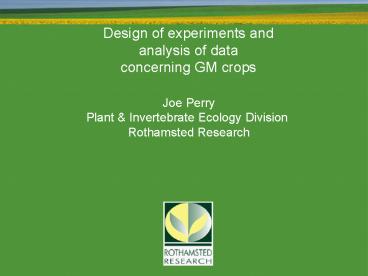Design of experiments and PowerPoint PPT Presentation
1 / 22
Title: Design of experiments and
1
Design of experiments and analysis of data
concerning GM crops
Joe Perry Plant Invertebrate Ecology Division
Rothamsted Research
2
Farm Scale Evaluations of GMHT Crops
Three spring-sown crops Beet, Spring oilseed
rape (SOSR), Maize all GMHT
Peter Rothery Joe Perry
Suzanne Clark
3
Herbicide-tolerance
Farm Scale Evaluations of GMHT Crops
4
GMHT Management
- Potent
- Flexible
- Context Is agriculture sustainable?
5
GMHT costs benefits
- Possible benefits
- reduced use of herbicides
- less persistent herbicides
- later sprays
- less need for insurance sprays
- Possible harm
- greater efficiency of weed control
- cleaning up weedier fields
- effect on invertebrates birds
Farm Scale Evaluations of GMHT Crops
6
The null hypothesis H0
- There is no difference between the management of
GMHT varieties and that of comparable
conventional varieties, in their effect on the
abundance and diversity of arable plants and
invertebrates. - Wildlife not food safety or gene flow
Farm Scale Evaluations of GMHT Crops
7
Statistical design of experiment
Randomized block experimental units are
half-fields
GM C
Farm 12
Farm 1
Year 1
Farm 36
Farm 13
Year 2
Farm 37
Farm 67
Year 3
Perry et al. (2003) Journal of Applied Ecology,
40, 1731
8
Design considerations
- Halved-fields or paired whole fields?
- GMHT management cost-effective weed control
- Effects on populations are multiplicative
- Power aim for 80 chance to detect x1.5-fold
effect - Sites representative of where crop grown in GB
- Fields representative of size
- Farms aim to include relatively large
proportion of - less-intensively managed
Farm Scale Evaluations of GMHT Crops
9
Size of the FSE
This research will not only address GM crops.
This is an extremely important opportunity to
gain a more detailed understanding of the
effects of agricultural management on farmland
wildlife generally Michael Meacher, 1999
We counted 700,000 plants 17,000 bees 13,000
butterflies We trapped 500,000 seeds 1.5
million invertebrates We made gt4000 visits to
fields analysed gt7000 datasets
Farm Scale Evaluations of GMHT Crops
10
Analysis - estimation
Analysis - testing
d mean difference in log-transformed catch
between GM and C in this example, d -2.32
2.34
0.02
A value of d 0.02 on the transformed scale is
equivalent to a value, termed R, of R x1.05
on the natural scale. Values of Rlt1 indicate
abundance for CgtGM. Values of Rgt1 indicate
abundance for GMgtC, here by 5.
- Site C GM
- 1 257 146
- 2 2201 1444
- 3 0 1
- 4 110 253
- ? ? ?
- 66 0 0
- 67 31 42
Site C GM 1 2.41 2.17 2 3.34 3.16 4 2
.04 2.40 ? ? ? 67 1.49 1.62
Assume V a µ2, so use c ? log10(c1)
transformation
H0 tested by randomization test. Involves
swapping pairs of values at random within sites,
and recomputing d
N, the number of sites, has been reduced by 2
Farm Scale Evaluations of GMHT Crops
11
Presentation of results - tables
What is being considered
How many sites were used in the comparison
Average numbers recorded per half-field
R, Ratio of numbers in GMHT compared with
conventional (following backcalculation after
logarithmic transformation of half-field total
count)
Statistical significance (calculated by
randomization test)
Farm Scale Evaluations of GMHT Crops
12
Conclusions
- GM cropping WILL affect farmland wildlife
- Effects result from differences in herbicide
management systems - Maize beneficial, beet and spring oilseed rape
harmful, compared with current conventional - All depends on management of crop, field
landscape - Differences between crops greater than
differences between GM and conventional
Farm Scale Evaluations of GMHT Crops
13
Consistency of treatment effects
Parallel line gt lack of density
dependence Treatment effect consistent over
initial weed levels years environments
distance into field most other covariates
displayed on graph as dashed line through scatter
R1, line of no effect
104 g per m2
Weed biomass for SOSR at harvest weight
on logarithmic scale GM versus Conventional colour
s refer to years
102 g per m2
treatment effect measured by displacement from
line of no effect
d -0.45, i.e. R 10d 0.35
104 g per m2
102 g per m2
Farm Scale Evaluations of GMHT Crops
14
Detectability of effects
Of 595 values, 131 (22) had R gt 1.5. Of
those 131 values, 107 (82) had p lt 0.05.
The size of effect does not depend on N, so is
consistent for rare and for more abundant species
Detectability increases with size of effect
(R) and with effective replication, N
15
Atrazine
Withdrawal within EU of atrazine, simazine and
cyanazine announced in September 2003, three
weeks prior to publication of results
Farm Scale Evaluations of GMHT Crops
16
Implications of atrazine withdrawal
Perry et al. (2004) Nature, 428, 313 316
Farm Scale Evaluations of GMHT Crops
17
http//www.rothamsted.bbsrc.ac.uk/pie/joe_general_
work_GM_FSE_page_3_1.htm
Downloads include the eight data papers published
in Phil. Trans. Roy. Soc. (2003), the Commentary
on the FSE (Firbank et al., 2003), and the
non-technical summary (Burke et al., 2003)
Farm Scale Evaluations of GMHT Crops
18
Work in progress
Data
Analysis of spatial pattern
19
(No Transcript)
20
(No Transcript)
21
(No Transcript)
22
Coexistence operates through sibsidiarity,
risk-assessment is EU-wide
Will integrate cross-pollination studies across
EU at field, landscape, region, national
scales with local and regional barriers Liability

